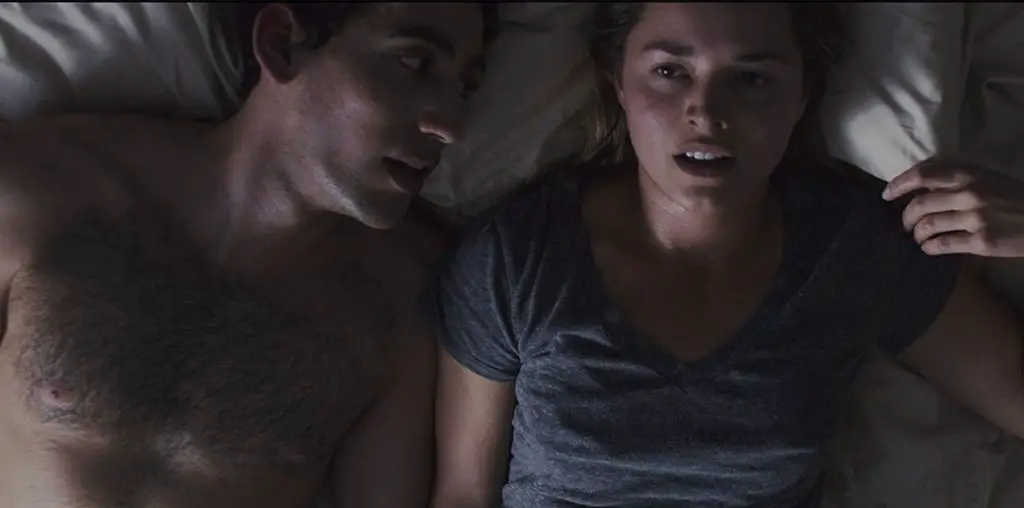
Like many contemporary movies, Michael Robinson’s absorbing, poetic film “Circle in the Sand,” is set in a post-apocalyptic world. It concerns itself with a familiar question: how will the few survivors view us and our world, after we’ve destroyed it? But Robinson’s utterly original take on this genre, and his oblique, metaphorical approach, make this film unique.
The first image, in an abstract, visual prolog to the piece, is of a glittering, sequin-covered curtain. This key image is echoed in many moments throughout the film, and seems to represent the tantalizing glitter that the artifacts of our technological era have for the post-apocalyptic survivors.
The film is set in a gorgeous, seemingly pristine land of shrubs and woods near a rocky coast, but the inhabitants keep coming across remnants from the technological past: radios, computers, plastic press-on nails. The people we see are living on the land in a fairly primitive way, but the constant background noise of airplanes and radios indicates that, somewhere, the technological world continues, if only as a kind of background echo. The camera continues to linger on images which glitter and sparkle, echoing the sequined curtain: dewdrops on a spider’s web, light bouncing off the ocean waves, embers in a fire.
We see three young women and four young men who inhabit this landscape, but the women and men live separately. They have a curious relationship with the CDs, magazines, and trinkets they keep finding buried in the sand. They carefully study the objects for clues, and they read aloud to each other excerpts from paperback novels. (It’s the only spoken dialog we hear, as they are not talkative people.) But they also ritualistically destroy the objects, and this veneration mixed with anger seems to be a kind of spiritual practice. A key line of text is superimposed on the images twice: “We wanted to destroy knowledge, but from within knowledge… We forget everything, so as to start over.”
The women dress in found remnants, such as you might pick up in a terrible thrift store, and they prefer to read romance novels. The men live in tents like boy scouts, and they read war novels. An oblique series of vignettes give clues about what’s going on here, without ever spelling out the details. The men seem to have certain rights over the women, and they take one of them prisoner. Since the men aren’t violent and the woman doesn’t resist, it appears to be part of an agreement between the two groups. Later, the other women rescue her, apparently by psychic means.
The inhabitants of this world have a peculiar mixture of passionate interest in the past and bored apathy. They have have lost most of their cultural knowledge and technological skills (although one man still knows how to drive a car). They are fascinated with the old clothes, jewelry, appliances, and magazines which they find, because they have lost the ability to make their own clothes or even to cook a meal or grow food. They live in a world of natural beauty, but they do not have detailed knowledge of the place in which they live. These young people look more like bored club kids. They don’t believe in their ability to create new culture. The men are only playing at being soldiers, in the same way that the women are playing at being archeologists or historians.
Robinson has created a deliberately open-ended narrative, which can yield many interpretations. Since the characters are all young, one of the things it suggested to me was the way the current younger generation views the vanished wildness and glamor of the hippie generation. In the gay world, for example, younger gay men know that there was a legendary group of men who had a genius for wild and brilliant culture, but then they were hit by an enormous disaster, and they were wiped out in large numbers. Is Robinson’s post-apocalyptic world the post-AIDS world where (in certain bleak moments) it can seem as if everyone has forgotten how to create a living, vibrant culture and community? Many younger artists are more involved in studying and re-creating work from the past than they are in making something new. (Of course, if you look in the right places, one can also see that current creative culture is very much alive and flourishing.)
In the middle of the film, one of the women studies a glossy magazine that she has found, and Robinson inserts an exquisitely wrought graphic sequence. The magazine pictures of happy, rich media stars are overlaid with celestial stars, which tantalizingly suggest constellations as they glitter. Apparently, to members of this tribe, looking at images from our world is like looking at the night sky: they see a random field which suggests significant patterns. In the horoscopes of the future, people gaze at artifacts from our world and try to discern the cosmic forces which order the universe. Later, the women are explicitly shown using the plastic press-on nails as a divining device, as one would cast bones or runes. “Circle in the Sand” depicts a world of exhausted survivors of a ruined world, groping for meaning from the glittering shards.
